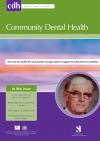Community Dental Health

- Cover Date:
- March 2012
- Print ISSN:
- 0265 539X
- Vol:
- 29
- Issue:
- 1
Promoting Positive Health Behaviours – ‘Tooth Worm’ Phenomenon and its Implications
doi:10.1922/CDH_2697Gao07
‘Tooth worm’ is a traditional belief about the pathogen of dental caries (tooth decay). Nevertheless, in our previous study, parental ‘tooth worm’ belief was linked to a reduced caries risk of their children. Objectives: This study aimed to further characterize the impact of parental ‘tooth worm’ belief on their children’s caries experience and its psychobehavioural mechanisms. Basic Research Design: analytic observational study. Setting: Thirteen randomly selected kindergartens in Singapore. Participants: 1,782 preschoolers aged 3-6 years. Methods: Each child received an oral examination and microbiological tests. Parents completed a self-administered questionnaire on their socio-demographic background, oral health knowledge/attitude and child’s oral health habits. Results: Multivariate analysis confirmed a reduced chance of ‘high caries rate’ (number of affected teeth>2) among children whose parents held the ‘tooth worm’ belief (Odds Ratio=0.41; 95% Confidence Interval=0.19-0.89). With such perception among parents, children brushed their teeth more frequently (p=0.042). Since no difference in oral hygiene was observed, the health benefit of the “tooth worm†perception may be acquired through the delivery of fluoride (an agent with proven anti-caries effect) during frequent toothbrushing episodes. Conclusions: This study revealed a ‘tooth worm’ phenomenon, indicating that parental ‘tooth worm’ belief is associated with early establishment of regular toothbrushing habit and reduction of dental caries in children. This phenomenon and its psychobehavioural mechanisms, enriching our understanding of oral health behaviours, have implications for effective health education.
Key words: health belief, health behaviour, culture, oral health, oral hygiene
- Article Price
- £15.00
- Institution Article Price
- £
- Page Start
- 55
- Page End
- 61
- Authors
- X.L. Gao, C.Y.S. Hsu, Y.C. Xu, T. Loh, D. Koh, H.B. Hwarng
Articles from this issue
- Title
- Pg. Start
- Pg. End
- The caries experience of 11 to 12 year-old children in Scotland and Wales and 12 year-olds in England in 2008-2009: Reports of co-ordinated surveys using BASCD methodology
- 8
- 13
- Variations in caries diagnoses and treatment recommendations and their impacts on the costs of oral health care
- 25
- 28
- Associated factors of tooth wear among Malaysian 16-year-olds: a case-control study in Kota Bharu, Kelantan
- 33
- 38
- Factors associated with self-assessed masticatory ability among community-dwelling elderly Japanese
- 39
- 44
- Development and testing of a theory-based behavioural change intervention: A pilot investigation in a nursery school in a deprived area of Scotland
- 62
- 67
- Illness-related behaviour and sociodemographic determinants of oral health care use in Dabou, Côte d’Ivoire
- 78
- 84
- Perception of oral health related quality of life (OHQoL-UK) among periodontal risk patients before and after periodontal therapy
- 90
- 94
- Dental Fluorosis, Dental Caries, and Quality of Life Factors among Schoolchildren in a Colombian Fluorotic Area
- 95
- 99
- Relationship of Periodontal Disease to Pre-term Low Birth Weight Infants in a Selected Population - A Prospective Study.
- 100
- 105
- Orofacial pain symptoms and associated disability and psychosocial impact in community-dwelling and institutionalized elderly in Hong Kong
- 110
- 116
- Association of hyposalivation with oral function, nutrition and oral health in community-dwelling elderly Thai
- 117
- 123
- Assessment of the relationship between perceptions of dental aesthetics and demand for orthodontic treatment in 10 – 11 year old school children in Birmingham, UK.
- 124
- 128
